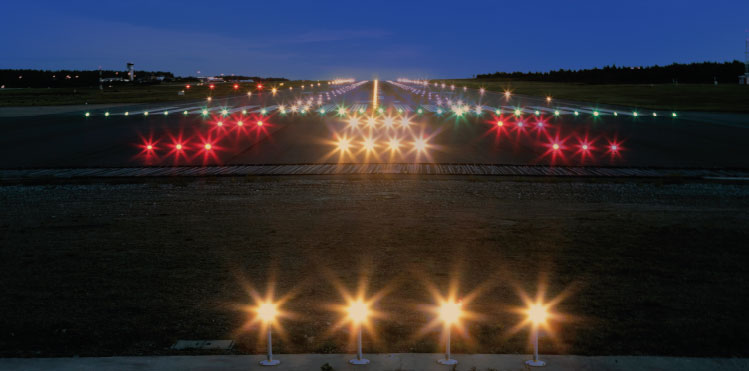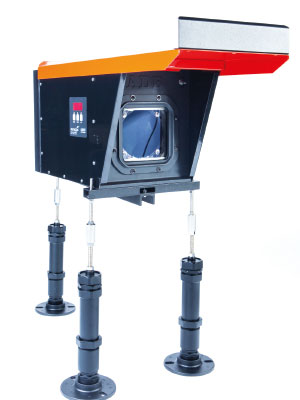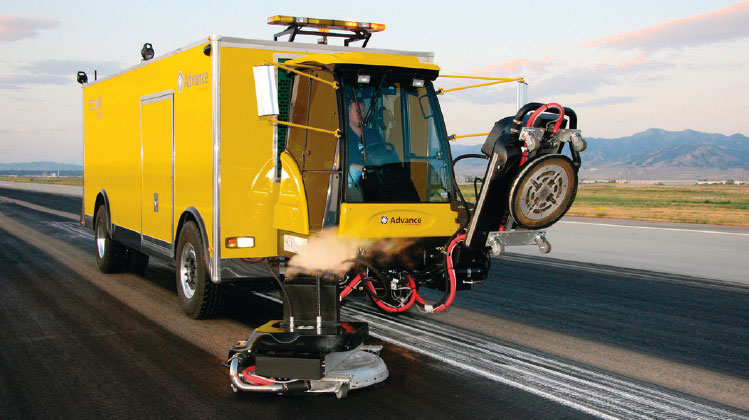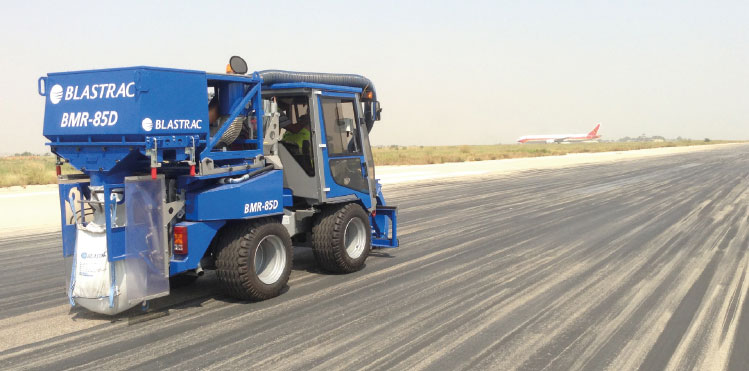
For large and complex airports like Amsterdam Airport Schiphol, integrated systems are essential. Safegate Group and its partners Imtech have recently been awarded the contract to provide the ASP-SafeControl integrated system to Schiphol’s bustling airfield. www.safegate.com
Safer runways with a smarter approach
“For as long as airfield safety remains a major concern, a combination of Airfield Ground Lighting (AGL) systems, LED airfield solutions, design and smarter maintenance will remain a priority for airport operators worldwide,” established Christian Onselaere, CEO of world-leading airfield technology company, and specialist in airfield lighting ADB Group. ADB provides end-to-end, integrated and sustainable solutions for visual guidance, including airfield and airport lighting, and recently implemented one of the world’s largest turnkey airfield ground lighting projects at the brand new Hamad International Airport in Doha.
By intelligently managing five key airfield aspects from landing to take-off, ADB believes airports can achieve ‘Smarter Safety and Reliability’. The Group’s answer to the challenges that face the airfields of today is its five-point strategy, starting with ‘Smarter Design’, which makes the best use of an airport’s topography and meteorological conditions, and incorporating its ‘Smarter Approach’ and ‘Smarter AGL’, including technology from Group companies – ADB Airfield Solutions, LUCEBIT and ERNI AGL.
Finally, ADB implements ICAO-compliant ‘Smarter Maintenance’, with its structured, preventive approach, to optimise airside availability and safety of maintenance staff.

ADB’s LED Papi, or Precision Approach Path Indicator, uses a single LED light channel on each light unit to provide the pilot with precise visual information, enabling the approach procedure to be performed with the utmost accuracy and safety.
ADB, Onselaere explained, is in a unique position to deliver its complete, all-LED ‘Smarter Approach’. “Fully ICAO-compliant, it comprises our proven LED AGL and LED Approach, Threshold, and Runway End lighting (LEAP), and ERNI’s LED Flashing lights and Approach Inset lights, our LED Papi – which offers several industry-firsts – as well as Exel’s frangible lattice masts and poles for approach lighting,” he said. “Together, these solutions deliver the superior energy efficiency, performance and cost benefits of an all-LED solution and allow our customers to benefit from safer and greener runways.”
ADB’s LED Papi, or Precision Approach Path Indicator, uses a single LED light channel on each light unit to provide the pilot with precise visual information, enabling the approach procedure to be performed with the utmost accuracy and safety. “We wanted to design the most user-friendly product possible, and that is what I guess we have achieved here,” Onselaere said. “Most of the maintenance burden of traditional Papis is about checking the alignment, and cleaning the interior from dust or sand at the occasion of the lamp change. The LED Papi makes that much easier – a digital display on the side of the unit shows in real time the inclination of the unit, meaning there is no more need to open the box, adjust the alidade and install it – a real maintenance-free product!”
ASP-SafeControl at Amsterdam Airport Schiphol
As an international transit hub that served over 52 million passengers in 2013 – with numbers expected to increase for 2014, Amsterdam Airport Schiphol heavily relies on state-of-the-art solutions to keep the airport moving, and Safegate Group, and its partners Imtech, have been awarded the contract to provide the ASP-SafeControl integrated system to Schiphol’s bustling airfield.
Safegate Group is a solutions provider for the airport industry, and as an Airfield Lighting (AFL) industry leader, it has over 20 years of experience with Individual Lighting Control and Monitoring Systems (ILCMS) – Safegate’s ASP-SafeControl. AFL is a large part of Safegate’s legacy, and with this contract at Schiphol, as well as a number of others, it continues to be an expanding part of the company’s future. ASP-SafeControl is an ILCMS that offers a range of benefits for airports. This integrated system enhances airport ground operations in terms of safety and efficiency, all the while contributing to the environmental investments and commitments of an airport. When critical airport areas need maintenance, ASP-SafeControl enables the tower to re-route airport traffic efficiently and safely with more awareness than before. It features proven backwards compatibility and uniquely designed easy-to-install hardware.
For large and complex airports like Amsterdam Airport Schiphol, integrated systems are essential. They minimise human error and improve coordination in various mission critical airport activities. With Safegate’s ASP-SafeControl, Schiphol will not only be able to improve its overall performance, but become a future-proof airport. Schiphol, if it so chooses, will be able to easily upgrade the ASP-SafeControl to enable the Follow the Green Concept in its everyday movements, which is essential to maintaining throughput in difficult weather conditions. Singapore Changi Airport already benefits from this advancement, and many airports are following this best practice for Category 3 conditions.
Innovative design, environmental approach
Fundamental to the safe and streamlined operation of an airfield are runways, taxiways and aprons free of contaminants and safety hazards. Over time, rubber build-up on airport runways creates a risk to the surface’s integrity. The Advance Cyclone 4006 deep cleans airport runway and apron surfaces more effectively, and in less time than other methods. A patented cleaning and recovery head cleans and removes rubber and paint build-up without damaging the surface – whether it is concrete or asphalt, and all water and debris is recovered without a vacuum via the solution’s exclusive cyclone technology, leaving nothing behind but a clean surface that dries quickly and is ready for immediate use.
Painted lines, meanwhile, are critical safety elements at airports and roadways. Advance’s Cyclone machines also remove painted lines without harming the surface, leaving it clean, dry and ready for repainting. 100% of the water used for cleaning, as well as the painted line debris, is recovered, ensuring an environmentally friendly solution to painted line removal.
Since its development in 1994, Advance’s Cyclone System has been tested in extreme environments, and used in some of the largest and dirtiest industrial areas in the world, including airport gates and runways. Throughout its product development and field-testing phases, Advance’s Cyclone has performed gate cleaning, runway rubber removal and paint line removal at most of the airports in the Pacific Southwest of the United States. Airports including Los Angeles, San Francisco, Phoenix Sky Harbor, San Diego, Portland International, Salt Lake City, Las Vegas McCarran, and St. Louis Lambert Field International Airport, to name but a few, can all depend upon the renewed reliability of their runway and apron areas thanks to Advance Cyclone Technology.
A great challenge for airports today is meeting operational cost targets, but the solutions of Advance Cyclone Technology satisfy this need. Its water consumption is extremely low – only 0.5 litres/sqm are used for rubber removal compared to the typical 1.5 litres/sqm. Less fresh water needed to filter also prolongs the life of the filter, while using less water also means that there is less to dispose, reducing disposal costs. The machine, meanwhile, requires just simple computer control, and is handled by one man, reducing resources needed to operate it while, as there is no complex pressure vessel or tank needed to power a vacuum since the technology operates on a cyclone principle, there is less maintenance cost.
Visionaries in surface preparation

The Advance Cyclone 4006 deep cleans airport runway and apron surfaces more effectively, and in less time than other methods. A patented cleaning and recovery head cleans and removes rubber and paint build-up without damaging the surface – whether it is concrete or asphalt, and all water and debris is recovered without a vacuum via the solution’s exclusive cyclone technology, leaving nothing behind but a clean surface that dries quickly and is ready for immediate use.
Today’s busy international airports handle ever-increasing levels of traffic, and necessary turnaround times for aircraft are becoming ever shorter. Modern airport runways have to be capable of safely landing new generation aircraft with greater weights and higher landing speeds. Therefore, the braking performance of pavement surfaces has become far more critical, making runway surface condition therefore pivotal to the safety of an airport’s operation. There are many elements that can impact upon the surface of a runway, including structure, materials used, surface type, weather conditions such as snow, ice or water, and contamination from various sources, but especially from rubber deposits.
Blastrac specialises in skid resistance and rubber removal, using blasting. The basic blasting process has been around for over 100 years, and Blastrac was the inventor of the first mobile shot blasting process in the early 1980s. It is now the global leader in this field. Operating in over 80 countries, the Blastrac product range now has some 65 machines, from handheld products to truck mounted and fully remote controlled blasters. The Blastrac system is a mechanical process, which is designed to remove surface contaminants, surface imperfections and coatings.

Operating in over 80 countries, the Blastrac product range now has some 65 machines, from handheld products to truck mounted and fully remote controlled blasters. The Blastrac system is a mechanical process, which is designed to remove surface contaminants, surface imperfections and coatings.
The process is fully controlled, safe and environmentally sound. It uses no water, no chemicals or solvents, emits no pollutants or dust to the atmosphere, and the removed material can often be fully recycled. In the process, steel shot is fed by gravity through a control valve into an impellor. The impellor, turning at high speeds, throws the steel shot through an adjustable opening at high velocity and at a specific angle on to the surface over which the self-propelled machine is travelling. The steel shot then impacts the surface and bounces off, and as it does so material from the surface – be this contaminants, coatings or the surface material itself is abraded, and any loose material, together with the shot is drawn up into the machine by the airflow created by a vacuum unit.
According to Blastrac, over recent years, independent research has shown that shot blasting is the most cost-effective, environmentally friendly and highest performing technology for reducing the danger of slippery runways. In April 2014, the Blastrac 1-10DS shot blaster was used at Dubai International Airport for thermoplastic line removal. The thermoplastic material was easily removed and therefore the job was done in no time, reaffirming the safety of the airfield at one of the busiest international hubs in the world.







